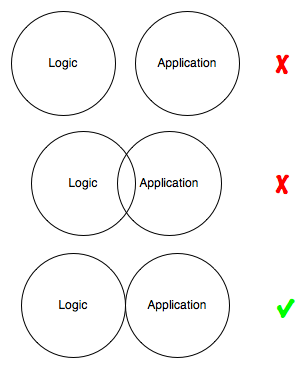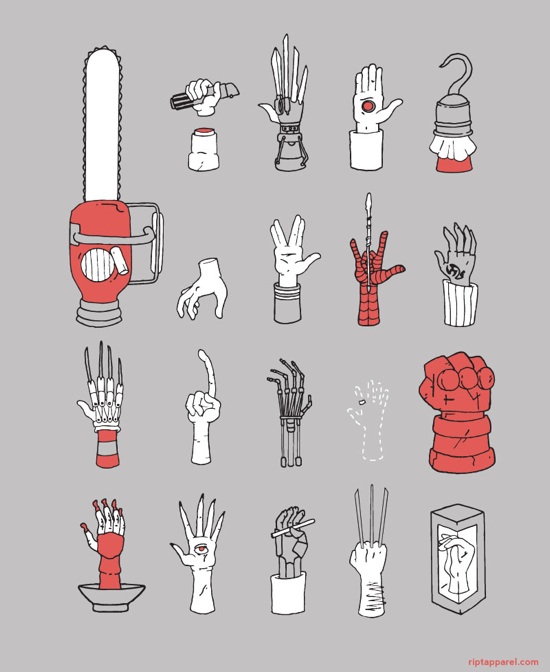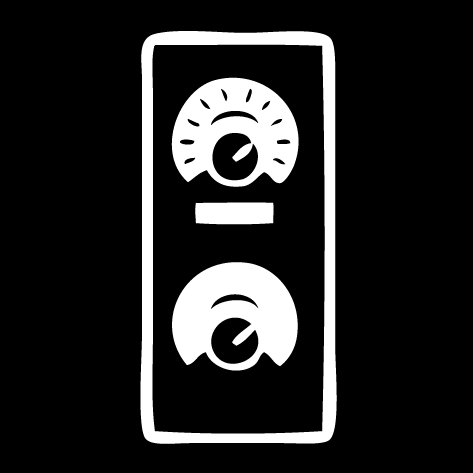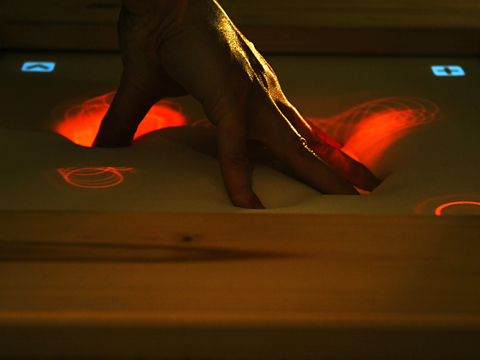synesthesia
How touchscreen buttons “should” feel
On 09, Aug 2011 | No Comments | In perception | By Dave
Researchers at the University of Tampere in Finland found that,
Interfaces that vibrate soon after we click a virtual button (on the order of tens of milliseconds) and whose vibrations have short durations are preferred. This combination simulates a button with a “light touch” – one that depresses right after we touch it and offers little resistance.
Users also liked virtual buttons that vibrated after a longer delay and then for a longer subsequent duration. These buttons behaved like ones that require more force to depress.
This is very interesting. When we think of multimodal feedback needing to make cognitive sense, synchronization first comes to mind. But there are many more synesthesias in our experience that can only be uncovered through careful reflection. To make an interface feel real, we must first examine reality.
“We’re suggesting that the ear evolved out of the skin in order to do more finely tuned frequency analysis.”
On 27, May 2011 | No Comments | In perception, physiology | By Dave
Recent research reveals some fun facts about aural-tactile synesthesia:
Both hearing and touch, the scientists pointed out, rely on nerves set atwitter by vibration. A cell phone set to vibrate can be sensed by the skin of the hand, and the phone’s ring tone generates sound waves — vibrations of air — that move the eardrum…
A vibration that has a higher or lower frequency than a sound… tends to skew pitch perception up or down. Sounds can also bias whether a vibration is perceived.
The ability of skin and ears to confuse each other also extends to volume… A car radio may sound louder to a driver than his passengers because of the shaking of the steering wheel. “As you make a vibration more intense, what people hear seems louder,” says Yau. Sound, on the other hand, doesn’t seem to change how intense vibrations feel.
The post where I coin the word “intersthesia”
On 01, Oct 2009 | No Comments | In language | By David Birnbaum
I’ve been thinking a lot lately about Merleau-Ponty’s claim that we experience transcendent things synesthetically. As I noted in this post, he says that we experience overlapping, multimodal layers of sensations that overflow beyond our sensory limits, and that the things comprising the layers transcend us (are independent of us, do not require us in order to exist—at least, that’s our experience).
But to me, synesthesia is the wrong word to describe overlapping, multimodal sensations. Overlapping means that there are seperable sensations, with different envelopes, that may co-occur. But the way I experience synesthesia is quite different. When I hear a loud, unexpected noise, it brings the sensation of bright color. Smells have texture. Flashing lights have an auditory rhythm. These combinations aren’t the result of exploration over time, and they don’t overflow. They aren’t like a coffee cup which can be seen, smelled, and touched at the same time. Synesthesia is self-contained. Synesthesia is integrated.
It’s pretty clear to me that Merleau-Ponty’s idea of synesthesia and the widely documented neurological condition by the same name are different phenomena. Therefore I think it’s important to use a different word to refer to each. So for the phenomenon that Merleau-Ponty is identifying, I say “intersthesia” is more apt. It better implies overlapping layers of sensation that come and go continuously, in multiple dimensions. With this new word, we can say that we are all intersthetic all the time, and some of us are synesthetic some of the time.
Merleau-Ponty’s philosophy
On 24, Sep 2009 | 3 Comments | In books | By David Birnbaum
“Yes or no: do we have a body—that is, not a permanent object of thought, but a flesh that suffers when it is wounded, hands that touch?” — The Visible and the Invisible
Merleau-Ponty’s Philosophy by Lawrence Hass was the first full book I read on the great phenomenologist. If you’re fascinated by sensation, perception, synesthesia, metaphor, and flesh (and frankly, who isn’t?), please read it! It offers many wonderful revelations. I’ll briefly review the following topics from the book:
- Sensation/perception is a false dichotomy.
- Perception is “contact with otherness.”
- Synesthesia is a constant feature of experience.
- The concepts of “reversibility” and “flesh”
Tactility in the Tractatus Logico-Philisophicus
On 01, Jul 2009 | No Comments | In books | By David Birnbaum
I’ve written before about the later writings of Wittgenstein and the metaphor of the word as a manual tool. However, in Ludwig’s first published work, the Tractatus Logico-Philosophicus, his theory of language is that sentences represent states of affairs, the so-called picture theory of language. Although he later abandoned that viewpoint for the tool-based one, I was intrigued by this historically significant switch-up, so I read through the Tractatus with special attention to its visual and tactile metaphors. Here are a few examples.
2.013
Each thing is, as it were, in a space of possible states of affairs. This space I can imagine empty, but I cannot imagine the thing without the space.
2.0131
A spatial object must be situated in infinite space. (A spatial point is an argument-place.)
A speck in the visual field, though it need not be red, must have some colour: it is, so to speak, surrounded by colour-space. Notes must have some pitch, objects of the sense of touch some degree of hardness, and so on.
This is a prime example of a sensory metaphor used throughout the book. Objects are described in a visual way, as being seen as situated within a possibility space or belief space. They themselves have extension, but we perceive them as taking up some amount of the visual field (surrounded by context, which here is represented as other possibilities for their position or physical attributes).
2.151
Pictorial form is the possibility that things are related to one another in the same way as the elements of the picture.
2.1511
That is how a picture is attached to reality; it reaches right out to it.
2.1512
It is laid against reality like a measure.
2.15121
Only the end-points of the graduating lines actually touch the object that is to be measured.
Again we get a visual metaphor described in terms of physicality. How is a picture “attached” to reality? It reaches out to it. And while it touches reality, it only just touches it, in a tangential way. Wittgenstein starts with a visual image and then writes “attached”, “reaches out”, “laid against”, and “touch”—all haptic metaphors.
2.1514
The pictorial relationship consists of the correlations of the picture’s elements with things.
2.1515
These correlations are, as it were, the feelers of the picture’s elements, with which the picture touches reality.
Now we have moved from the picture as a “measure,” a passive geometry tool, to a picture as an agent. Not just any agent, but an agent with a capacity for haptic perception. What is a “feeler”? To me that word means a mobile extremity with sense organs which can be used to find out about the world. So, what Wittgenstein seems to be saying here is that when we generate a picture in our mind, it’s as if we are extending our hand into the world.
4.002
…
Language disguises thought. So much so, that from the outward form of the clothing it is impossible to infer the form of the thought beneath it, because the outward form of the clothing is not designed to reveal the form of the body, but for entirely different purposes.
In other words, thoughts are like physical objects. A word envelops a thought. We have a thought and then we toss a word-robe over it and shove it onto the stage of discourse where it can interface with other enrobed thoughts.
4.411
It immediately strikes one as probable that the introduction of elementary propositions provides the basis for understanding all other kinds of proposition. Indeed the understanding of general propositions palpably depends on the understanding of elementary propositions.
Once again, a tactile metaphor (“palpably”) is used for emphasis and to indicate comprehensive understanding.
5.557
…
What belongs to its application, logic cannot anticipate.
It is clear that logic must not clash with its application.
But logic has to be in contact with its application.
Therefore, logic and its application must not overlap.
I.e.,

Is “overlap” a haptic metaphor or a visual one? It could be either, or both.
6.432
How things are in the world is a matter of complete indifference for what is higher. God does not reveal himself in the world.
6.4321
The facts all contribute only to setting the problem, not to its solution.
6.44
It is not how things are in the world that is mystical, but that it exists.
6.45
To view the world sub specie aeterni is to view it as a whole—a limited whole.
Feeling the world as a limited whole—it is this that is mystical.
To feel is to know, silently, mystically.
I was pretty surprised at how easy it seems to foresee Wittgenstein’s turn from the eye to the hand. He presents what he calls a picture theory of language, but it repeatedly leads to a description of solid objects in space, or bodies moving and feeling and contacting each other. Of course I’m reading with a very biased perspective. Not only is my goal to hunt for tactile metaphors but I also know how the story ends some 30 years later. Still, I can’t help but feel that the tactile language in the Tractatus may foreshadow the shift to come.
Real time effects for daily living
On 15, Apr 2009 | No Comments | In music | By David Birnbaum
A breakthrough iPhone application called RjDj allows you to go about your daily business listening to the world through real-time audio effects. Similarities to drugs and to movie soundtracks are mentioned in the video, but this is much, much bigger and cooler than those. RjDj uses motion and sound sensors to layer digitally mapped feedback over everyday experience. It’s a step toward pre-processing all of the sensory stimuli flowing into your body so that they’re optimized for comfort, pleasure, and information density. I predict this is going to become one of the central uses of mobile computers, and RjDj suggests that it’s already on its way.
(via Althouse)








